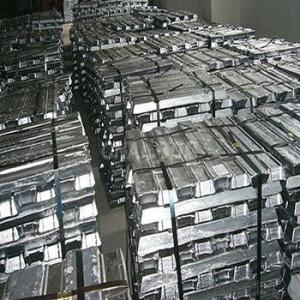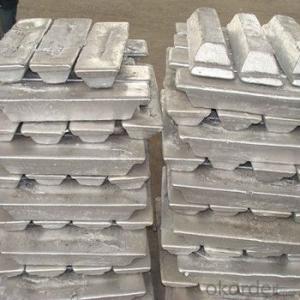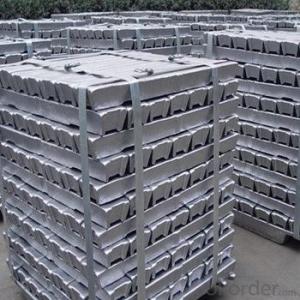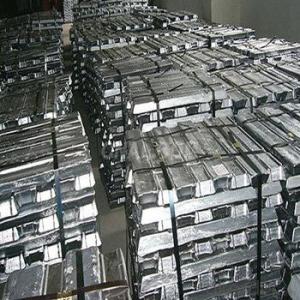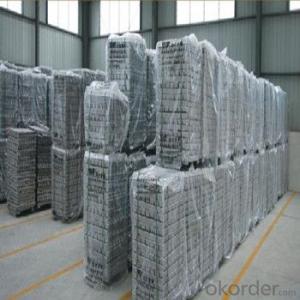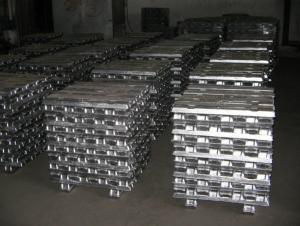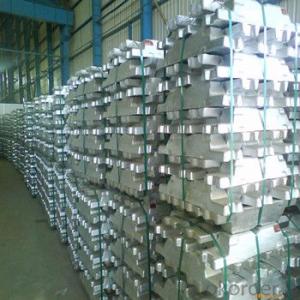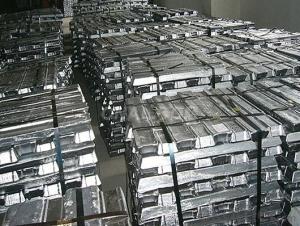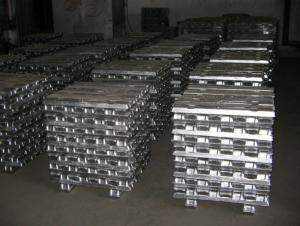Aluminium Ingot 99.7% Pure /Primary Aluminium Ingots Good Quality
- Loading Port:
- China main port
- Payment Terms:
- TT OR LC
- Min Order Qty:
- 1000 m.t.
- Supply Capability:
- 10000 m.t./month
OKorder Service Pledge
OKorder Financial Service
You Might Also Like
Pure Aluminum Ingot Used for Industry
1.Structure of Aluminum Ingot Description
A material that has been cast into a shape in order to be transported and processed easier than in an unprocessed form. An ingot is typically rectangular in shape, which allows it to be stacked. Ingots are most commonly associated with metals, with ingots of gold held in the vaults of banks and brokerages being popular images.
2.Main Features of the Aluminum Ingot
•High Purity
•High strength
•Fast melting
•Best price
•Good after-service
3. Aluminum Ingot Images


4. Aluminum Ingot Specification
Grade | Chemical Composition % | |||||||||
Al≥ | impurities ≤ | |||||||||
Si | Fe | Cu | Ga | Mg | Zn | Mn | others | Sum | ||
Al99.9 | 99.90 | 0.50 | 0.07 | 0.005 | 0.02 | 0.01 | 0.025 | - | 0.010 | 0.10 |
Al99.85 | 99.85 | 0.80 | 0.12 | 0.005 | 0.03 | 0.02 | 0.030 | - | 0.015 | 0.15 |
Al99.7 | 99.70 | 0.10 | 0.20 | 0.010 | 0.03 | 0.02 | 0.030 | - | 0.030 | 0.30 |
Al99.6 | 99.60 | 0.16 | 0.25 | 0.010 | 0.03 | 0.03 | 0.030 | - | 0.030 | 0.40 |
Al99.5 | 99.50 | 0.22 | 0.30 | 0.020 | 0.03 | 0.05 | 0.050 | - | 0.030 | 0.50 |
Al99.00 | 99.00 | 0.42 | 0.50 | 0.020 | 0.03 | 0.05 | 0.050 | - | 0.050 | 1.00 |
5.FAQ of Aluminum Ingot
We have organized several common questions for our clients,may help you sincerely:
①How about your company?
A world class manufacturer & supplier of castings forging in carbon steel and alloy steel,is one of the large-scale professional investment casting production bases in China,consisting of both casting foundry forging and machining factory. Annually more than 8000 tons Precision casting and forging parts are exported to markets in Europe,America and Japan. OEM casting and forging service available according to customer’s requirements.
②How to guarantee the quality of the products?
We have established the international advanced quality management system,every link from raw material to final product we have strict quality test;We resolutely put an end to unqualified products flowing into the market. At the same time, we will provide necessary follow-up service assurance.
③How long can we receive the product after purchase?
In the purchase of product within three working days, We will arrange the factory delivery as soon as possible. The pecific time of receiving is related to the state and position of customers.Commonly 7 to 10 working days can be served.
- Q:How is the purity of an aluminum ingot determined?
- The purity of an aluminum ingot is typically assessed using various analytical techniques, with one of the most common methods being the utilization of a spectrometer to measure the elemental composition. This method, known as optical emission spectroscopy (OES) or spark testing, involves vaporizing a small sample of the ingot using an electric spark and analyzing the resulting emission of light. Each element emits a distinct spectrum of light, and by comparing the intensities of these spectral lines to known standards, the concentration of different elements in the ingot can be determined. This allows for the identification and quantification of impurities such as iron, copper, silicon, and other trace elements. Another approach to evaluating purity is through chemical analysis, which entails dissolving a sample of the ingot in an appropriate acid or solvent and conducting various chemical reactions to quantify the impurities. For instance, atomic absorption spectroscopy (AAS), a common technique, can be utilized to measure the concentration of specific elements in the solution. In addition to these analytical techniques, non-destructive tests like ultrasound or X-ray analysis can also be employed to assess the integrity and purity of the aluminum ingot. These methods are capable of detecting any internal flaws or inclusions that could potentially impact the quality of the ingot. In conclusion, a combination of these analytical techniques is employed to determine the purity of an aluminum ingot, ensuring that it meets the necessary specifications for diverse industrial applications.
- Q:How is aluminum ingot produced?
- Aluminum ingot is produced through a process known as smelting. The first step in this process involves the extraction of bauxite, which is a mineral rich in aluminum oxide. Bauxite is mined from open-pit mines and then refined to remove impurities. Once the refined bauxite is obtained, it is then converted into alumina through a chemical process called the Bayer process. In this process, the bauxite is dissolved in a solution and heated under pressure, resulting in the formation of alumina. The alumina is then transported to smelting facilities where it is further processed to produce aluminum ingots. The smelting process involves the use of electrolysis, where the alumina is dissolved in a molten cryolite bath and subjected to an electric current. This causes the aluminum ions to be attracted to the cathode, where they collect and solidify into ingots. After solidification, the ingots are removed from the electrolytic cell and further processed to meet specific requirements. They are typically cast into large blocks or rectangular shapes to facilitate storage and transportation. Overall, the production of aluminum ingots involves a series of complex processes starting from the extraction of bauxite to the smelting and casting of aluminum. These ingots then serve as the raw material for various industries that utilize aluminum in the production of a wide range of products.
- Q:What are the different alloying elements used in aluminum ingots?
- Aluminum ingots can be enhanced with various alloying elements to improve their properties and characteristics. Some commonly utilized alloying elements are: 1. Copper (Cu): To increase the strength and hardness of the alloy, copper is frequently added to aluminum ingots. Copper-aluminum alloys, also known as aluminum bronzes, exhibit outstanding corrosion resistance and find extensive usage in marine applications. 2. Zinc (Zn): Aluminum ingots often incorporate zinc as an alloying element to enhance the metal's castability. Aluminum-zinc alloys, like the 7000 series, possess high strength, good corrosion resistance, and are prevalent in aerospace and automotive applications. 3. Magnesium (Mg): Magnesium is a widely employed alloying element in aluminum ingots, especially in the 5000 series alloys. It improves aluminum's strength, machinability, and provides excellent corrosion resistance. Aluminum-magnesium alloys are commonly utilized in structural applications. 4. Silicon (Si): The addition of silicon to aluminum ingots improves their casting characteristics and reduces solidification shrinkage. Aluminum-silicon alloys, such as the 4000 series, exhibit good fluidity and are often employed in automotive and electronic components. 5. Manganese (Mn): Aluminum ingots can incorporate manganese as an alloying element to increase strength and improve corrosion resistance. Aluminum-manganese alloys, like the 3000 series, possess good formability and are commonly used in the construction and packaging industries. 6. Chromium (Cr): Aluminum ingots can be enriched with chromium to enhance their heat resistance and mechanical properties. Aluminum-chromium alloys, such as the 2000 series, are frequently employed in aerospace and high-temperature applications. 7. Lithium (Li): In small quantities, lithium, a lightweight and highly reactive element, is utilized to create aluminum-lithium alloys with high strength and low density. These alloys are primarily utilized in aerospace applications where weight reduction is crucial. These represent only a fraction of the alloying elements employed in aluminum ingots. The selection of alloying elements depends on the desired properties of the final product and its intended application.
- Q:How does the ADC12 die casting aluminium ingot contain copper?
- If the Cu exceeds the standard, and the quantity of the aluminum ingot is large enough, you can make a batch of low copper alloy mixture. But the above are more complicated. Since the aluminum ingot is not qualified, it is better to be replaced by the aluminum ingot maker
- Q:What are the advantages of using aluminum ingots in the production of medical devices?
- There are several advantages of using aluminum ingots in the production of medical devices. Firstly, aluminum is a lightweight metal, making it ideal for medical devices that need to be portable and easy to handle. It reduces the overall weight of the device, making it more comfortable for patients and easier for healthcare professionals to use. Secondly, aluminum has excellent corrosion resistance properties. This is crucial in medical devices as they often come into contact with various bodily fluids and chemicals. By using aluminum ingots, manufacturers can ensure that the medical devices will not corrode or degrade over time, thus increasing their lifespan and reliability. Additionally, aluminum is highly malleable and can be easily shaped and formed into intricate designs. This allows for the production of complex medical devices with precise specifications. The versatility of aluminum ingots enables the creation of devices that can fit various anatomical structures, ensuring a better fit and improved functionality for patients. Furthermore, aluminum is a non-toxic material and does not react with human tissues. It is biocompatible, meaning it can be safely used in medical devices that come into direct contact with the body, such as implants, surgical instruments, and prosthetics. Aluminum's biocompatibility reduces the risk of adverse reactions or complications for patients. Lastly, aluminum ingots are cost-effective compared to other metals commonly used in medical device production. The abundance of aluminum ore and its relatively low cost of extraction make it a more affordable option for manufacturers. This cost-effectiveness can lead to more accessible medical devices, benefiting patients and healthcare systems worldwide. In conclusion, the advantages of using aluminum ingots in the production of medical devices include their lightweight nature, excellent corrosion resistance, malleability, biocompatibility, and cost-effectiveness. These properties make aluminum a suitable choice for creating high-quality, durable, and safe medical devices.
- Q:What kind of material is die casting aluminium ingot?
- Material / model1, according to the content of aluminum ingot content is divided into1) advanced pure aluminum: aluminum content of 99.93%-99.999%2) industrial high-purity aluminum: aluminum content of 99.85%-99.90%3) industrial pure aluminium: the content of aluminium is 98.0%-99.7%2, remelting with aluminum ingot according to the chemical composition is divided into 6 grades: (Note: Al after the number is aluminum content)
- Q:What is the difference between a aluminium ingot with and without a ticket?
- Beijing's purchase price is the price of aluminum, aluminum ingot + processing fees, billing is generally not a ton of processing fee will be about 400 yuan less, your price is overall, the overall profits can be, I think do not have to manage open ballot problem of aluminum ingots.
- Q:What are the different surface treatments for aluminum ingots?
- There are several different surface treatments available for aluminum ingots, depending on the desired outcome and application. Some commonly used surface treatments for aluminum ingots include: 1. Anodizing: This is a process that creates a protective oxide layer on the surface of the aluminum ingot. Anodizing can provide corrosion resistance, increase durability, and improve the aesthetic appearance of the aluminum. 2. Powder coating: Powder coating involves applying a dry powder to the surface of the aluminum ingot, which is then cured under heat to form a protective and decorative coating. Powder coating offers excellent resistance to corrosion, fading, and scratching, while also providing a wide range of color options. 3. Polishing: Polishing is a mechanical process that involves buffing the surface of the aluminum ingot to achieve a smooth and glossy finish. This treatment enhances the appearance of the aluminum and can also improve its resistance to corrosion. 4. Brushing: Brushing is a surface treatment that involves using abrasive brushes to create a textured or brushed finish on the aluminum ingot. This treatment is often used to achieve a decorative or industrial look, while also providing a certain level of corrosion resistance. 5. Chemical etching: Chemical etching is a process that involves using chemicals to selectively remove material from the surface of the aluminum ingot. This treatment can create intricate patterns, logos, or text on the surface of the aluminum, making it suitable for branding or decorative purposes. 6. Clear coat: Applying a clear coat to the surface of the aluminum ingot can provide an additional layer of protection against corrosion, while also preserving the natural appearance of the metal. Clear coats often contain protective additives that enhance the longevity of the aluminum. It is important to consider the specific requirements of the application and consult with professionals in the field to determine the most suitable surface treatment for aluminum ingots.
- Q:How are aluminum ingots used in the production of kitchen utensils?
- Aluminum ingots are used in the production of kitchen utensils due to their unique properties and advantages. Firstly, aluminum is a lightweight metal that is easy to handle, making it ideal for manufacturing utensils that are comfortable to use. Additionally, aluminum has excellent heat conductivity, allowing for quick and even heat distribution when cooking. This property is especially important for pots, pans, and other cookware, as it ensures that food is cooked evenly and efficiently. Moreover, aluminum is highly resistant to corrosion and rust, making it a durable material for kitchen utensils. This feature is crucial, as kitchen utensils are often exposed to water, heat, and various chemicals during cooking and cleaning. Furthermore, aluminum is a non-reactive metal, meaning it does not react with acidic or alkaline foods. This makes it safe to use for all types of cooking, including those involving acidic ingredients like tomatoes or citrus fruits. To produce kitchen utensils, aluminum ingots are melted down and cast into the desired shapes using molds. The ingots are heated to their melting point and then poured into the molds, where they solidify and take the form of the utensil. Afterward, the utensils are polished, coated, or anodized to enhance their appearance, durability, and non-stick properties. In conclusion, aluminum ingots are extensively utilized in the production of kitchen utensils because of their lightweight nature, excellent heat conductivity, corrosion resistance, non-reactivity, and durability. These properties make aluminum an ideal material for creating a wide range of cookware that is efficient, safe, and long-lasting.
- Q:Want to do a scrap processing of aluminum ingots of small workshops, about investment of about 100 thousand, the specific process, need what equipment technology, please expert advice
- I suggest actually visiting the small workshop. I was in this industry before. Another important point, the water rate, is able to turn out 100 kilograms of scrap aluminum water how many kilograms, finally cooled into aluminum ingots, which is the key of this industry
1. Manufacturer Overview |
|
|---|---|
| Location | |
| Year Established | |
| Annual Output Value | |
| Main Markets | |
| Company Certifications | |
2. Manufacturer Certificates |
|
|---|---|
| a) Certification Name | |
| Range | |
| Reference | |
| Validity Period | |
3. Manufacturer Capability |
|
|---|---|
| a)Trade Capacity | |
| Nearest Port | |
| Export Percentage | |
| No.of Employees in Trade Department | |
| Language Spoken: | |
| b)Factory Information | |
| Factory Size: | |
| No. of Production Lines | |
| Contract Manufacturing | |
| Product Price Range | |
Send your message to us
Aluminium Ingot 99.7% Pure /Primary Aluminium Ingots Good Quality
- Loading Port:
- China main port
- Payment Terms:
- TT OR LC
- Min Order Qty:
- 1000 m.t.
- Supply Capability:
- 10000 m.t./month
OKorder Service Pledge
OKorder Financial Service
Similar products
New products
Hot products
Related keywords
